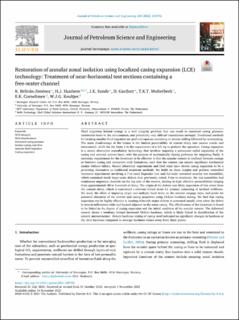| dc.contributor.author | Beltran Jimenez, Katherine | |
| dc.contributor.author | Skadsem, Hans Joakim | |
| dc.contributor.author | Sunde, Jonas Kristoffer | |
| dc.contributor.author | Gardner, Dave | |
| dc.contributor.author | Wolterbeek, Timotheus K T | |
| dc.contributor.author | Cornelissen, Erik | |
| dc.contributor.author | Keultjes, Wout J. G. | |
| dc.date.accessioned | 2021-11-19T14:39:48Z | |
| dc.date.available | 2021-11-19T14:39:48Z | |
| dc.date.created | 2021-11-14T15:40:48Z | |
| dc.date.issued | 2021-11 | |
| dc.identifier.citation | Beltran Jimenez, K., Skadsem, H.J., Sunde, J.K. et al. (2021) Restoration of annular zonal isolation using localized casing expansion (LCE) technology: Treatment of near-horizontal test sections containing a free-water channel. Journal of Petroleum Science and Engineering, 109792 | en_US |
| dc.identifier.issn | 0920-4105 | |
| dc.identifier.uri | https://hdl.handle.net/11250/2830532 | |
| dc.description.abstract | Fluid migration behind casings is a well integrity problem that can result in sustained casing pressure, undetected leaks to the environment, and potentially very difficult remediation attempts. Traditional methods for treating annular fluid migration are perf-and-squeeze cementing or section milling followed by recementing. The main disadvantage of the former is the limited penetrability of cement slurry into narrow cracks and microannuli, while for the latter it is the requirement of a full rig to perform the operation. Casing expansion is a recent alternative remediation technology that involves imposing a permanent radial expansion of the casing and external cement layer, with the purpose of mechanically closing pathways for migrating fluids. A necessary requirement for the treatment to be effective is that the annular cement is confined between casings or between casing and competent rock formations, such that the cement can sustain significant mechanical strains without failure. Recent laboratory experiments and field trials have shown casing expansion to be a promising alternative to traditional treatment methods. We build on these insights and perform controlled treatment experiments involving a 7-in Local Expander tool and full-scale cemented annulus test assemblies, which contained much larger-scale defects than previously tested. Prior to treatment, the test assemblies had continuous migration channels on the top side of the cement, leading to high effective permeabilities ranging from approximately 80 to hundreds of darcy. The origin of the defects was likely separation of free water from the cement slurry, which is considered a relevant failure mode for primary cementing of inclined wellbores. We study the effect of imposing single and multiple local dents on the annular seepage rates, and probe for potential alteration of the cement and casing properties using Vickers hardness testing. We find that casing expansion can be highly effective in treating relatively major defects in cemented annuli, even when the defect is several millimeters wide and located adjacent to the outer casing. The effectiveness of the treatment is found to be linked to the degree of casing expansion and the initial condition of the annular cement. The deformed cement shows a tendency toward increased Vickers hardness, which is likely linked to densification of the cement microstructure. Vickers hardness testing of casing steel indicated no significant changes in hardness at the dent locations compared to average hardness values away from these points. | en_US |
| dc.language.iso | eng | en_US |
| dc.publisher | Elsevier Ltd. | en_US |
| dc.rights | Navngivelse 4.0 Internasjonal | * |
| dc.rights.uri | http://creativecommons.org/licenses/by/4.0/deed.no | * |
| dc.subject | petroleumsteknologi | en_US |
| dc.subject | brønnteknologi | en_US |
| dc.title | Restoration of annular zonal isolation using localized casing expansion (LCE) technology: Treatment of near-horizontal test sections containing a free-water channel | en_US |
| dc.type | Peer reviewed | en_US |
| dc.type | Journal article | en_US |
| dc.description.version | publishedVersion | en_US |
| dc.rights.holder | © 2021 The Authors | en_US |
| dc.subject.nsi | VDP::Teknologi: 500::Berg‑ og petroleumsfag: 510::Petroleumsteknologi: 512 | en_US |
| dc.source.journal | Journal of Petroleum Science and Engineering | en_US |
| dc.identifier.doi | 10.1016/j.petrol.2021.109792 | |
| dc.identifier.cristin | 1954352 | |
| dc.relation.project | Norges forskningsråd: 308767 | en_US |
| dc.source.articlenumber | 109792 | en_US |
| cristin.ispublished | true | |
| cristin.fulltext | postprint | |
| cristin.qualitycode | 2 | |

